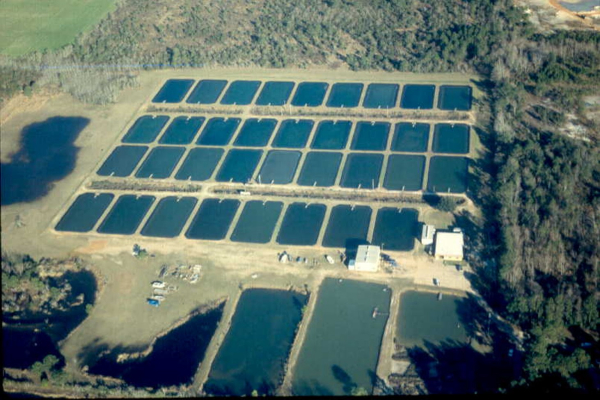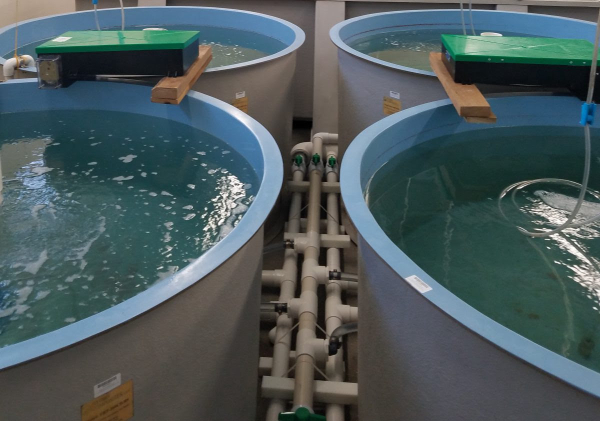

|
Back in 1970, a kind woman named Ms. Mildred Casey donated 40 acres of land in South Alabama to the State. And it was the start of something beautiful.
After purchasing an additional 5 acres to connect Ms. Casey’s land to the brackish water of the Intracoastal Waterway, the Claude Peteet Mariculture Center (CPMC) in Gulf Shores was born. In 1973, 35 ponds and a small pump station were installed, and in 1975, a small hatchery building was constructed for broodstock holding and egg fertilization and hatching.
For the last half-century, CPMC has been a crucial component of the Alabama seafood industry’s sustainability efforts. Without their work, various populations of Gulf species could be at risk of overfishing or other environmental risks. So if you’ve enjoyed an Alabama Gulf Seafood dinner recently, you can thank CPMC for helping keep fresh product on the market.
We spoke with Chief Biologist Kevin Anson to learn a little bit more about CPMC and the work they do for our industry. Here’s what he had to say.
What was the mission of the CPMC when it was founded in 1970?
The property deed for the donated acres stipulated that the property would always be used by the state as a fish hatchery. For the first 15 years of CPMC, the main objective was the spawning and rearing of striped bass for release in local waters.
Was the CPMC the first facility of its kind in Alabama?
CPMC was the first marine finfish hatchery of its size in Alabama. Other freshwater hatcheries both private and public were established in the state, but CPMC was the first large marine finfish hatchery in the state and remains the largest marine finfish hatchery in the state.
How many people does the CPMC employ today?
CPMC has eight full-time staff dedicated to care and maintenance of fish and maintenance of grounds and facilities. Throughout the year, an additional 4-6 people may be used for short periods to assist with maintenance, broodfish collection, or harvesting activities.
How has the CPMC changed over the last 50 years?
The main goal of CPMC to produce fish for stocking purposes has not changed. However, the infrastructure used to raise fish has changed in that period. There have been three major changes to CPMC infrastructure. The first change was the installation of HDPE pond liners for the 35 0.2 acre outdoor ponds in 1986 to prevent loss of water in the ponds and minimize seawater intrusion into the aquifer due to seepage. The second major change or event was the installation of a 2.5 mile long, 6” PVC pipeline from the Gulf of Mexico to the ponds. Prior to the pipeline being constructed, the only saltwater available on the property was to pump from the Intracoastal Waterway or to mix concentrated salt with groundwater. The full-strength seawater provided by the new pipeline greatly improved the ability of CPMC staff to maintain optimum water quality for broodfish and improved spawning and hatch success of released eggs. The final major change occurred with the construction of a new 23,000 ft2 hatchery building in 2012. The new building replaced a much smaller hatchery building constructed in 1973 and significantly expanded the broodstock quarantine and holding space and the larval and juvenile fish rearing capacity. In addition, the new building also contains rooms for live foods culture, laboratory equipment, and walk-in cold and freezer storage.
What sort of work goes into a typical day at the CPMC?
A typical day includes water quality monitoring (check dissolved oxygen, water temperature, and salinity), food preparation and feeding of broodfish and/or juvenile fish, culture of rotifers (small zooplankton) used for feeding recently hatched fish, and pump and filter maintenance.
Previous species that the CPMC has focused on include Red Snapper, Red Drum, Spotted Seatrout, Florida Pompano, Eastern Oysters, and Gulf Shrimp. What species are you focused on nowadays?
We are currently focused on Florida Pompano, Southern Flounder, and Spotted Seatrout (Speckled Trout). Auburn University conducts various shrimp research in about half of the ponds. In the next year, a new oyster hatchery facility will be constructed on CPMC grounds for producing oysters needed in restoration and enhancement projects.
Has the CPMC been involved in the culturing of farm-raised oysters in recent years?
CPMC has not been involved with farm-raised oyster operations. However, CPMC’s forthcoming oyster hatchery may be available to that group in the future, although managers will only consider that possibility if no other sources are available.
What are the CPMC’s goals for the years ahead?
The primary goal would be to continue the culture of marine finfish species which have recreational value. If additional funding is available, some of the fish reared at CPMC could be used to expand the list of cultured species to include those which may be listed as endangered or threatened.
Why are resources like the CPMC important for Alabama’s seafood industry?
CPMC can offer several benefits to the seafood industry. First, releasing fish can increase populations and speed up recovery of natural populations affected by natural or man-made die-offs. Second, reared fish can be used in studies to better estimate fishing mortality, or they can be used to better understand growth and movement patterns both of which assists fisheries managers in the decision-making process. Finally, information gathered in the process of feeding, spawning, and rearing fish can be applied to commercial aquaculture facilities to improve the production capacity and improve economic efficiencies of the operations which could reduce pressure on wild harvests.
What makes Alabama Gulf Seafood special?
Gulf seafood is among the best in the world because of the level of fisheries management, both state and federal, used to maintain sustainable populations. Alabama seafood is special because of its link to the Alabama’s unique coastal culture and history.